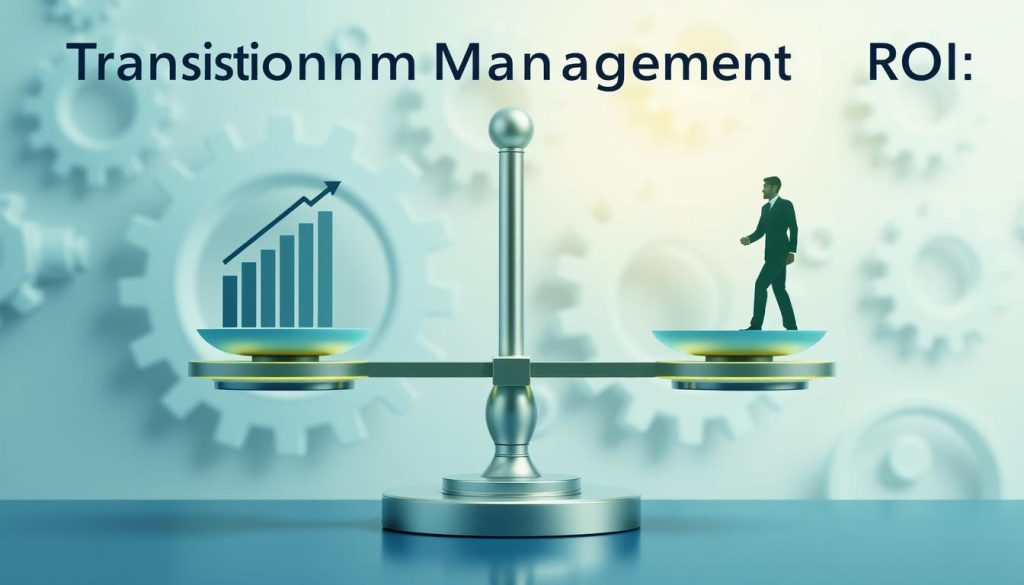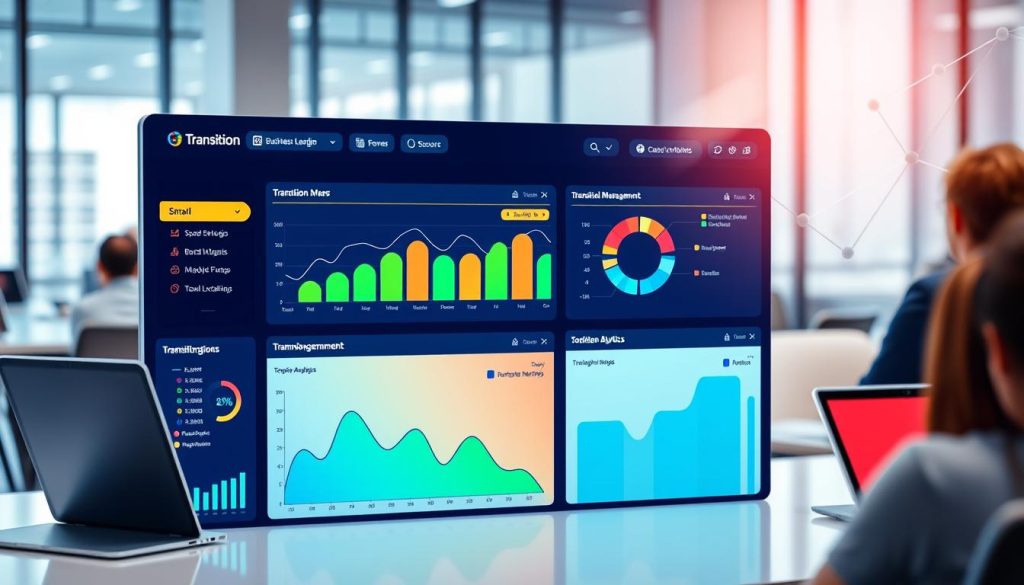In today’s fast-paced business world, companies often face tough transitions. These can include mergers, acquisitions, or changes in strategy. Transition managers, or « Managers de Transition » in French, are experts in leading through these times. They have the skills and experience to guide companies smoothly through these challenges.
Transition managers are not just regular executives. They are seasoned professionals with years of experience in different industries. Their ability to achieve results, even when things get tough, makes them stand out. They combine practical skills with strategic thinking, making them crucial for any big change.
Whether a company wants to improve, turn things around, or adapt to new trends, transition managers can lead the way. They are great at handling unexpected changes, keeping the business running smoothly. In today’s world, where digital changes are essential, they know how to help companies adopt new tech and processes.
Also, transition managers are experts in helping companies grow and change. They know how to manage change management effectively. They use proven strategies to drive successful changes. By coaching on change and using their transition skills, they help companies adapt to new ways of working.
Table of Contents
Key Takeaways
- Transition managers are expert business leaders who guide organizations through complex transitions and transformations.
- They possess a unique blend of practical execution capability and strategic thinking, delivering genuine results in challenging situations.
- Transition managers excel in navigating classic turnarounds, managing unplanned exits, and leading digital transformations.
- They are skilled in organizational development, change management, and transition facilitation.
- Transition managers help organizations overcome resistance to change and embrace new ways of working.
Understanding the Role of Transition Managers
In today’s fast-changing business world, companies face big challenges. They need experts to lead them through tough times. That’s where transition managers come in. They have the skills and experience to help companies change and grow.
Definition and Scope
Transition management is about leading change in companies. This can happen when there’s a new leader, a merger, or a big change in strategy. Transition managers are experienced leaders who help keep things stable and focused during these times.
What a transition manager does can vary. But they usually help in a few key ways. They assess the company’s current state, plan for the future, manage daily tasks, and talk to stakeholders.
Key Responsibilities
Transition managers are key in helping companies through tough times. They do many important things. They plan and execute strategies, manage change, lead teams, watch finances, and build relationships with stakeholders.
By doing these things, transition managers help companies stay strong and ready for the future.
Importance in Business Restructuring
Business restructuring is hard and needs careful planning and leadership. Transition managers are crucial in this process. They offer fresh views, bring expertise, help with leadership changes, and keep everyone focused.
Here are some facts that show how important transition management is:
| Statistic | Value |
|---|---|
| Cost of executive transitions as a percentage of annual salary | 213% |
| Percentage of executive transitions viewed as failures or disappointments after two years | 27-46% |
| Percentage of leadership transitions that stumble due to politics, culture, and people | 68% |
| Percentage of CEOs who reshuffle their management teams within the first two years | 69% |
These numbers show the risks and costs of leadership changes. But with a good transition manager, companies can avoid these problems and thrive in changing times.
When to Consider a Transition Manager
In today’s fast-paced business world, companies often need temporary leadership. Transition managers, or interim managers, offer the needed expertise. They help navigate through tough times and ensure business keeps running. But when is the right time to hire a transition manager?
One common reason for hiring a transition manager is when a company lacks the right skills. This could be due to a skill gap or the need for specialized knowledge. A transition manager with the right skills can guide the company through these challenges.
Signs Your Business Needs Temporary Leadership
Another reason is when a company faces a crisis that needs quick action. This could be a financial issue, a regulatory problem, or a major operational challenge. McKinsey & Co. says up to 46% of leadership changes fail within two years. Transition managers are experts in crisis management and can quickly turn things around.
Common Scenarios Requiring Transition Management
Leadership gaps are another reason to hire a transition manager. This could happen when a key executive leaves suddenly, is ill, or on maternity leave. A transition manager can fill this gap, ensuring the company keeps running smoothly until a permanent leader is found.
Transition management is useful in many sectors, like industrial, service, distribution, and public services. Whether it’s a manufacturing firm, a healthcare merger, or a new government policy, transition managers can lead the way. They bring the expertise needed to manage these complex situations.
When looking for a transition manager, find someone with the right skills and experience. They should have a track record of successful transitions in similar fields. They should also be good at leading and communicating, and able to work well with teams and stakeholders.
The Skills and Qualities of Effective Transition Managers
Transition managers are key in helping businesses through tough times. They need skills like strategic thinking, problem-solving, and leadership. They also need to be good at communicating and adapting to change.
Good transition managers are efficient, flexible, and open. They are quick to solve problems and manage well. They can handle stress and come up with bold solutions.
They move from being specialists to generalists. They go from solving problems to setting the agenda. This helps them lead through change.
Strategic Thinking and Planning
Transition managers must think strategically. They create plans that tackle the challenges of change. They set goals, think about obstacles, and make a roadmap for success.
They also plan how to test the change. This ensures a smooth transition with little loss.
Adaptability and Problem Solving
Being adaptable is crucial in change management. It means being able to adjust to new situations. Transition managers need to be flexible and open-minded.
They must be able to solve problems quickly. They adapt their plans as needed. Building a supportive network helps employees adjust to change.
| Skill | Importance |
|---|---|
| Communication | Preparing employees for change, overcoming resistance, breaking down complexities, setting realistic expectations, reducing confusion and misinformation |
| Adaptability | Adjusting to environmental changes, fostering self-awareness, flexibility, and open-mindedness, building supportive networks |
| Leadership | Guiding teams through transitions, providing stability, clarity, setting direction, inspiring confidence in achieving organizational goals |
Leadership and Communication Skills
Leadership is key in guiding teams through change. It provides stability and sets direction. It inspires confidence in achieving goals.
Communication is also vital. It prepares employees for change and helps overcome resistance. Clear, consistent, honest, and empathetic communication reassures employees.
Failing to manage change can lead to demoralized employees resenting disorganization and errors, emphasizing the importance of essential change management skills.
Other important skills include stakeholder engagement, analytical thinking, and time management. Conflict resolution, customer focus, and resource management are also crucial. Documentation and risk management are important too. By combining these skills, transition managers can lead organizations through change successfully.
The Benefits of Hiring a Transition Manager
In today’s fast-paced business world, companies often face big challenges. Hiring a transition manager can be a big help. These managers bring a lot of experience and a fresh view to help solve tough problems.
One key benefit is getting quick access to specialized skills. These experts have a track record of success in similar situations. They can start making a difference right away, helping companies tackle urgent issues without adding permanent staff.
Immediate Expertise and Experience
Transition managers are great at leading teams because of their experience. They focus on their specific tasks, leading to quick results. Their outside view brings new ideas that might not come from inside the company.
| Benefit | Description |
|---|---|
| Specialized Skills | Transition managers have the specific skills needed to solve certain problems |
| Proven Experience | They have a history of success in similar situations |
| Rapid Deployment | They can start working quickly, often in just a few days |
Objective Perspective on Business Challenges
Another big plus is their unbiased view of business challenges. As outsiders, they’re not swayed by company politics. This allows them to give honest advice that’s best for the company.
The interim manager must establish clear communication channels and foster collaboration to ensure a successful transition.
Also, they’re experts in handling crises and talking to all stakeholders. They plan and adapt strategies to ensure a smooth transition. They also help manage resistance to change, a common hurdle in big changes.
How to Choose the Right Transition Manager
Choosing the right transition manager is key to your company’s success. It’s important to work with firms that have many qualified candidates. These firms check each manager’s skills, experience, and salary to find the best fit for your company.
To make a good choice, your company needs to know what it needs. This includes the type of change, the stakes, and what results you want. Knowing these details helps you find the right candidate.
Evaluating Candidates’ Experience
When looking at candidates, focus on their experience with similar changes. Look at their:
- Relevant industry experience
- Success in leading change
- Ability to handle complex stakeholders
- Strategic planning and execution skills
A good transition manager knows the challenges and opportunities of change. They have the skills to develop and carry out effective strategies.
Assessing Cultural Fit with Your Organization
It’s also important to see if the candidate fits your company’s culture. A manager who shares your company’s values and style will build trust and teamwork. This is crucial during changes.
| Cultural Fit Criteria | Evaluation Methods |
|---|---|
| Leadership style | Behavioral interviews, personality assessments |
| Communication skills | Simulated scenarios, stakeholder feedback |
| Adaptability | Case studies, problem-solving exercises |
| Alignment with company values | Value-based interviews, reference checks |
By carefully checking candidates’ experience and cultural fit, you can pick the best transition manager. They will have the skills and fit to lead your company through change.
Transition Management vs. Traditional Management
In today’s fast-changing business world, more companies are using transition management to handle big changes. This method is different from traditional management, which focuses on small steps and keeping things stable. Transition management is all about leading through major shifts.
A study looked at 38 studies from 10 countries and found a big increase in using transition management in healthcare. The most used models were Kotter’s and Lewin’s. These models show how effective they are in making changes, from small areas to big systems.
Key Differences in Approach
Transition management is different from traditional management in many ways. While traditional management sticks to what’s known, transition managers bring new ideas. They can suggest changes that others might not think of.
Also, transition management is short-term focused. It’s not like traditional management, which looks ahead for a long time. This short-term focus makes transition management more flexible and quick to adapt. It helps in making important changes fast.
Impact on Organizational Change
The effect of transition management on change is huge. It helps in big projects, new structures, and crisis management. Transition managers are key in helping companies through tough times.
They need special skills to do their job well. They must think strategically and come up with plans that fit the company’s goals. They also need to solve problems quickly and lead teams well. Good communication is key to getting everyone on board with change.
As the business world keeps changing fast, the need for good transition managers will grow. Companies that use transition management and have these skilled leaders will be ready for any change.
The Process of Transition Management
Transition management helps organizations smoothly move from one state to another. It involves planning, implementing, and monitoring changes. This ensures the desired outcomes are met with minimal disruption.
Steps to Implementing Change
The process starts with analyzing the current state and identifying needed changes. Key stakeholders are brought in to set goals, scope, and timeline. A detailed plan is made to outline the steps for change.
Effective change needs clear communication, training, and support for employees. Prosci’s studies show projects with great change management are seven times more likely to succeed. The cost of a transition PMO varies, with a typical range of 500 to 2,500 euros per day. The process happens in four phases.
- Analysis of the current situation and company needs
- Setting key performance indicators (KPIs)
- Developing an action plan
- Measuring the results achieved
Monitoring and Adjusting Strategies
It’s important to keep track of progress and adjust strategies as needed. Regular reviews and feedback help ensure goals are met. The transition manager coordinates teams, allocates resources, and updates stakeholders.
| Change Management Quality | Likelihood of Meeting Objectives |
|---|---|
| Excellent | 88% |
| Poor | 13% |
Good change management is linked to staying on schedule and budget. Experienced transition managers help navigate complex changes. Their strategic thinking, project management skills, and inclusive approach are key to successful transformations.
Case Studies: Successful Transition Management
Real-world examples show how skilled interim leaders help organizations through tough times. These stories show how transition managers handle complex situations, drive change, and get results.
Corporate Turnarounds
In corporate turnarounds, transition managers are key. They bring new ideas, spot areas for betterment, and set up change plans. They focus on making operations better, fixing finances, and setting new strategies.
One example is a leading manufacturing company’s turnaround. It was losing market share and facing financial issues. A transition manager was brought in to lead the change. They quickly improved operations and cut costs. They also got the team to work together towards a common goal, boosting productivity and profits.
Navigating Mergers and Acquisitions
Mergers and acquisitions are complex and need transition managers’ skills. They help merge companies’ cultures, systems, and processes to create value.
A great example is the smooth merge of two global tech firms. The transition manager created a detailed integration plan. They tackled issues like keeping talent, talking to customers, and merging systems. Their work ensured a smooth transition, with little disruption and quick benefits from the merger.
These stories show how important interim leaders are in tough business times. They use their knowledge, flexibility, and strategic thinking to help companies come out stronger.
The Financial Implications of Transition Management

Transition management helps companies change smoothly. It has financial sides to consider. When a company hires a transition manager, they must think about the costs and benefits. A detailed cost-benefit analysis is key to see if it’s worth it.
The costs include the manager’s salary and the consulting firm’s fees. But, these costs are often less than the benefits. A good transition manager can make a company more efficient, increase sales, and get projects done well. This leads to a good return on investment (ROI).
Here are some interesting facts:
- Global greenhouse gas emissions have gone up, reaching about 59 metric gigatons in 2019. This is a 12% increase from 2010.
- To keep global warming at 1.5 degrees Celsius, emissions must drop by almost half by 2030.
- To reach net-zero emissions by 2050, we need to invest $275 trillion in new assets.
- Private banks could give $3.5 trillion a year for 28 years to help.
These numbers show the big challenge and how important transition management is. It helps companies meet global goals and benefit from a low-carbon economy.
Evaluating the ROI of Transition Management
To check the ROI of transition management, companies must see if they meet their goals. They should look at how well they do over time. This means watching key performance indicators (KPIs) and comparing them to the costs.
Good transition management can bring big financial gains. By investing in reducing emissions, companies can lead the way to a green future. This is good for the planet and can make a company more attractive to investors and customers.
« Transition management is proposed as part of transdisciplinary research, aiming at systematic development and empowerment of actors to facilitate sustainability transitions. » – Research study on transition management
The financial effects of transition management vary by company. But, by looking at the transition management costs and benefits, companies can make smart choices. These choices can lead to financial success and help the planet.
Challenges Faced by Transition Managers
Transition managers guide organizations through big changes. They face challenges like resistance to change and managing different stakeholder interests. These hurdles can make their job tough.
Resistance to Change
Change resistance is a big issue. Employees might feel unsure or skeptical about new ideas. A study of 225 companies found that change success depends on four key factors, including employee effort.
Transition managers must tackle this resistance to succeed. Research shows that two-thirds of transformation programs fail. This highlights the need to manage resistance well.
To overcome resistance, transition managers can:
- Clearly explain the benefits and need for change
- Involve employees in the change process and listen to their ideas
- Offer training and support to help employees adjust
Navigating Stakeholder Interests
Aligning stakeholder interests is another big challenge. Different groups, like executives, employees, and partners, have different priorities. Transition managers need strong leadership and communication to build trust and find common ground.
| Stakeholder Group | Potential Interests | Strategies for Alignment |
|---|---|---|
| Executives | Financial performance, strategic direction | Demonstrate how the transition supports long-term goals |
| Employees | Job security, career development | Provide transparency and opportunities for growth |
| External Partners | Continuity of operations, contractual obligations | Maintain open communication and fulfill commitments |
By addressing stakeholder concerns and aligning their interests, transition managers can foster a supportive environment for change.
« The DICE framework has been used to predict outcomes and guide execution of over 1,000 change management programs worldwide with successful outcomes. »
Conducting DICE assessments can help identify potential problem areas and make necessary adjustments for program success. Anticipating and managing challenges related to change resistance and stakeholder management can greatly improve success rates.
The Future of Transition Management
Businesses are always changing, and transition management is key. This field is growing because of new trends, tech, and the value of interim leaders. These leaders help companies change smoothly.
Emerging Trends in the Industry
More companies want interim managers with special skills. They need experts in digital change, supply chain, or merging companies. This shows the need for ongoing learning for these managers.
Using data to make decisions is another big trend. Managers who use data tools to track progress and make smart choices are very effective.
Technology’s Impact on Transition Management
New tech is changing how managers work. Cloud platforms help teams talk and share info easily, even from afar. This makes it easier to keep projects moving forward.
AI and ML will soon be even more important. They can look at lots of data, find patterns, and give insights. This helps managers see problems early and act fast.
« The DICE framework fosters successful change by sparking senior leadership debate about project strategy and improving change effectiveness, enabling companies to manage portfolios of projects efficiently. »
The table below shows how tech can help with transition management:
| Aspect of Transition Management | Potential Impact of Technology |
|---|---|
| Communication | Enhanced collaboration through cloud-based platforms |
| Data Analysis | Improved decision-making through AI and ML insights |
| Progress Tracking | Real-time monitoring and reporting using digital tools |
| Risk Assessment | Predictive analytics to identify and mitigate potential issues |
As tech gets better, managers who use these tools will do a great job. They’ll help companies change smoothly and add value.
Transition Management in Different Sectors
Transition management works well in many industries, each with its own challenges and chances. By knowing what each sector needs, transition managers can make plans that work. This helps drive change and improve business results.
Healthcare Sector Examples
In healthcare, transition management is key for dealing with new rules, tech, and better patient care. It helps during big changes like mergers or new setups. Transition managers keep care smooth, make things run better, and help patients get better.
A study showed leaders need to be good at working across different parts of the company. This is very true in healthcare, where teams must work together well for change to succeed.
Manufacturing Industry Insights
In manufacturing, transition management means making production better, using less waste, and handling supply chain issues. Managers here aim to make things run smoother, cut down on waste, and make products better. They help teams find and fix problems and bring in new ways of doing things.
| Change Model | Key Components |
|---|---|
| McKinsey 7-S | Strategy, Structure, Systems, Shared values, Skills, Style, Staff |
| Kotter’s 8-Step Process | Create urgency, Build team, Define vision, Communicate, Identify roadblocks, Short-term goals, Maintain momentum, Sustain changes |
| ADKAR | Awareness, Desire, Knowledge, Ability, Reinforcement |
| Bridges Transition Model | Ending, losing, and letting go; The neutral zone; The new beginning |
Manufacturing managers use change models like McKinsey 7-S, Kotter’s 8-step, or ADKAR. These models help lead change well, making sure everything important is covered. This gets the company ready for big changes.
By using specific strategies for each industry, companies can handle change better. Transition managers offer valuable knowledge to help companies grow and succeed, no matter the sector.
Training and Development for Transition Managers
In the fast-paced world of business, transition managers are key to guiding companies through change. They must keep learning and improving to excel. By taking part in key training and always learning, they can keep up with trends and add great value to their clients.
Essential Training Programs
Transition managers get a lot from training that covers many areas, such as:
- Change management methodologies
- Leadership techniques
- Project management
- Sector-specific knowledge
These programs give transition managers the tools to handle changes well. A 2019 study showed that 90% of workers felt better at their jobs after training. This not only boosts their skills but also makes them happier and more likely to stay.
Continuous Learning Opportunities
Along with formal training, transition managers should look for ongoing learning chances. This includes:
- Workshops
- Conferences
- Online courses
- Mentorship programs
By keeping up with new trends and best practices, transition managers can offer fresh solutions. A 2019 survey by Instructure found that 70% of U.S. workers might leave for a job that values training.
| Learning Opportunity | Benefits |
|---|---|
| Workshops | Hands-on experience, networking |
| Conferences | Industry insights, trend updates |
| Online Courses | Flexibility, self-paced learning |
| Mentorship Programs | Guidance, knowledge sharing |
The only thing worse than training your employees and having them leave is not training them and having them stay.
Henry Ford, American industrialist
By focusing on training and growth, companies can keep the best transition managers. This helps both the managers and the businesses they work for.
The Role of Communication in Transition Management
Effective communication is key to success in transition management. As companies face big changes, like digital transformations or new strategies, clear communication is vital. Transition managers need to focus on team communication to make sure everyone knows what’s happening and why.
Studies reveal that 70% of change efforts fail because of bad communication and leadership. To avoid this, managers must create detailed plans for change communication. These plans should match the company’s goals and what employees need to do differently. By knowing the situation, who will be affected, and where problems might arise, managers can pick the best ways to talk to employees and help them adopt the change.
Keeping Teams Informed
Transition managers must keep teams updated during changes. They do this through regular updates in team meetings, emails, or company-wide talks. This keeps employees involved and informed. It also builds trust and helps reduce resistance to change.
Strategies for Effective Communication
To make communication in transition management work, managers should use several strategies:
- Tailoring messages for different groups
- Using simple language for complex ideas
- Adding visuals and multimedia to help people understand
- Encouraging open talks and listening
- Celebrating achievements and thanking employees
By using these effective communication strategies, managers can create a supportive space. This space helps employees accept change and work towards the company’s goals. Employees’ understanding and support are essential for the success of any transition.
Leveraging Technology for Transition Management

In today’s fast-paced business world, technology is key for transition managers. It helps them streamline processes, improve teamwork, and make smart decisions. This makes navigating changes easier.
Tools and Software for Transition Managers
Transition managers use many tools and software to do their jobs. Platforms like Asana and Trello help them plan and track projects. This ensures everyone is on the same page and deadlines are met.
Tools like Slack and Microsoft Teams make it easy to work together in real-time. This is crucial for success in transition management.
Studies show that embracing digital transformation helps organizations reach their goals:
- 8 out of 10 companies have started digital transformation in the last five years.
- Small companies with fewer than 100 employees are 2.7 times more likely to succeed than big ones.
- Companies using more advanced technologies like AI and IoT are more likely to transform successfully.
The Role of Data Analysis
Data analysis is vital in technology-enabled transitions. It helps managers spot trends, track progress, and fine-tune strategies. This data-driven approach lets them make informed decisions and adjust quickly.
| Industry | Digital Transformation Success Rate |
|---|---|
| High Tech, Media, and Telecom | Up to 26% |
| Oil and Gas | 4% – 11% |
The table shows success rates vary by industry. But, the right technology and talent can boost success. Companies are three times more likely to succeed with the right digital talent and development programs.
« We have seen two years of digital transformation in two months. » – Satya Nadella, CEO of Microsoft
The COVID-19 pandemic has sped up digital technology adoption. It shows the need for agility and adaptability in transition management. Transition managers who use technology well will lead their companies to success.
Networking and Support for Transition Managers
Transition managers deal with big challenges like leading teams through change. They need to network and get support to succeed. By connecting with others, they can share knowledge and learn from experiences.
Groups like the « France Transition » federation help with transition manager networking. These groups have events, workshops, and discussions. This way, transition managers can grow their support networks and keep up with new trends.
It’s also important to build informal support networks. Connecting with colleagues and industry leaders can offer valuable advice. These relationships help when making tough decisions or facing complex situations.
The Benefits of Peer Support
In the interim management community, peer support is key. Transition managers share similar challenges. Talking with peers can be very helpful.
« Connecting with other transition managers has been a game-changer for me. Knowing that I’m not alone in facing these challenges and having a network of supportive peers has made all the difference in my career. » – Sarah, Transition Manager
Continual Learning and Development
Networking and support also help with learning and growing. Transition managers can find training and resources through the interim management community. Many professional associations offer courses and certifications.
Putting time into building strong support networks is worth it. Transition managers can overcome challenges and find new opportunities. This way, they can achieve more in their roles.
Conclusion: The Value of Transition Managers
Transition managers play a key role in helping organizations through tough changes. They are strategic, action-oriented, and bring great value to businesses. Their expertise helps companies drive change, overcome hurdles, and find new chances.
Summary of Key Points
Transition managers have special skills like strategic thinking and strong leadership. They offer immediate help and a fresh view on business problems. By picking the right transition manager, companies can smoothly implement change and adjust strategies when needed.
The Future of Leadership in Business Transitions
The need for skilled transition managers will keep growing as the business world changes fast. The Bridges Transition Model shows how important it is to support people through change. It focuses on communication, understanding change’s impact, and tracking progress through different phases.
The future of leadership in business transitions depends on adaptable and insightful professionals. They must handle the emotional and psychological sides of job changes. By using theories like Cognitive Dissonance and stress-coping, they can help leaders and organizations through leadership changes. As businesses see the value of interim management, the role of transition managers will keep expanding.
FAQ
What is transition management?
Transition management is when senior executives lead projects for a few months. They help with new projects, drive change, and manage crises. These experts bring a strategic view to achieve results in any market.
When should a company consider hiring a transition manager?
Companies should think about hiring a transition manager when they need specific skills. This is true for crises, technical problems, or when a manager is away. It’s useful in many sectors.
What skills and qualities make an effective transition manager?
Good transition managers are efficient, flexible, and open. They are quick to learn and manage well. They have skills like strategic thinking, adaptability, and communication.
How does transition management differ from traditional management?
Transition management is focused and short-term. It’s independent from internal politics. Managers can suggest bold ideas that others might not dare to.
What are the benefits of hiring a transition manager?
Hiring a transition manager brings in expertise without adding permanent staff. They manage teams well and propose innovative solutions. Their role is clear and short-term.
How do companies choose the right transition manager?
Companies work with specialized firms to find the right manager. These firms check the manager’s experience and fit. The company defines what they need and selects based on that.
What challenges do transition managers face?
Transition managers face challenges like resistance to change. They must lead and communicate well to overcome this. Building trust and aligning stakeholders is key.
How does technology impact transition management?
Technology helps transition managers with tools for planning and collaboration. It supports data-driven decisions. This makes managing projects more effective.
What training and development opportunities are available for transition managers?
Training is vital for transition managers to stay updated. They learn about change management, leadership, and project management. Continuous learning keeps them adaptable.
How can transition managers leverage networking and support?
Networking helps transition managers share knowledge and find opportunities. Professional organizations offer a platform for sharing best practices. A strong support network is crucial for growth.
Source Links
- The 7 Key Transitions Great Leaders must Make & Take in 2022 – https://www.imd.org/research-knowledge/leadership/articles/seven-transitions-good-leaders-must-make/
- Bridges Transition Model – William Bridges Associates – https://wmbridges.com/about/what-is-transition/
- Successfully transitioning to new leadership roles – https://www.mckinsey.com/capabilities/people-and-organizational-performance/our-insights/successfully-transitioning-to-new-leadership-roles
- Succession Planning for Nonprofits/ Managing Leadership Transitions – https://www.councilofnonprofits.org/running-nonprofit/governance-leadership/succession-planning-nonprofits-managing-leadership
- Effective Leadership Transition: A 6-Step Guide for Communicators – https://www.yourthoughtpartner.com/blog/leadership-transition
- Leadership transitions – https://hbr.org/topic/subject/leadership-transitions
- What strategies can you use to prepare your team for a major organizational transition? – https://www.linkedin.com/advice/3/what-strategies-can-you-use-prepare-your-team-pljrc
- 6 Crucial Skills for Successful Change Management – Pollack Peacebuilding Systems – https://pollackpeacebuilding.com/blog/change-management-skills/
- What are the most important skills for a transition manager? – https://www.linkedin.com/advice/1/what-most-important-skills-transition-manager
- Vertical mobility: the transition management solution – https://www.reactive-executive.com/en/vertical-mobility-how-can-transition-management-be-the-key/
- Transition Management: Making Change Happen | Boost’rh – https://www.boostrh.com/en/transition-management-making-change-happen/
- Choosing Strategies for Change – https://hbr.org/2008/07/choosing-strategies-for-change
- Top 10 change management models: A comparison guide – https://www.zendesk.com/blog/change-management-models/
- Where Do Models for Change Management, Improvement and Implementation Meet? A Systematic Review of the Applications of Change Management Models in Healthcare – https://pmc.ncbi.nlm.nih.gov/articles/PMC7966357/
- What steps can you take to develop a transition management plan? – https://www.linkedin.com/advice/0/what-steps-can-you-take-develop-transition-management-1l3ne
- Preparing an Organization for Sustainability Transitions—The Making of Boundary Spanners through Design Training – https://www.diva-portal.org/smash/get/diva2:1588145/FULLTEXT01.pdf
- What is Change Management and How Does it Work? – https://www.prosci.com/blog/what-is-change-management-and-how-does-it-work
- Transition PMO | Reactive Executive – https://www.reactive-executive.com/en/metiers/transitional-pmo/
- MSc Management for Sustainability Transitions – Program – Grenoble Ecole de Management – https://www.grenoble-em.com/en/programs/msc-management-in-sustainability-transitions
- A transition management framework to stimulate a circular phosphorus system – Environment, Development and Sustainability – https://link.springer.com/article/10.1007/s10668-021-01504-y
- PDF – https://eprints.whiterose.ac.uk/188170/3/Rincon-Moreno et al 2022_Industrial symbiosis in Humber region-transition management framework_accepted version.pdf
- Stocktake on Financial Institutions’ Transition Plans and their Relevance to Micro-prudential Authorities – https://www.ngfs.net/sites/default/files/stocktake_on_financial_institutions_transition_plans.pdf
- Financing the net-zero transition: From planning to practice – https://www.mckinsey.com/capabilities/risk-and-resilience/our-insights/financing-the-net-zero-transition-from-planning-to-practice
- Linking transitions and sustainability: A study into social effects of transition management – https://www.econstor.eu/bitstream/10419/148641/1/87512626X.pdf
- The Hard Side of Change Management – https://hbr.org/2005/10/the-hard-side-of-change-management
- Developing leaders by supporting their transitions into senior positions | Terblanche – https://sajbm.org/index.php/sajbm/article/view/12/109
- Managers are at odds during a team transition. How can you navigate the power struggle effectively? – https://www.linkedin.com/advice/1/managers-odds-during-team-transition-how-can-you-navigate-jtnqe
- What do you do if your team members are facing challenges during a late career transition? – https://www.linkedin.com/advice/0/what-do-you-your-team-members-facing-challenges-lcy1e
- Managing Transitions: Using William Bridges’ Transition Model and a Change Style Assessment Instrument to Inform Strategies and Measure Progress in Organizational Change Management – https://digitalcommons.butler.edu/cgi/viewcontent.cgi?article=1073&context=librarian_papers
- Importance of Training and Development for Employees – https://online.maryville.edu/blog/importance-of-training-and-development/
- Change Management Communication: 5-Step Plan + Template – https://www.yourthoughtpartner.com/blog/change-management-communication
- How to Communicate Change: 7 Best Practices (2024) – https://whatfix.com/blog/best-practices-change-management-communication/
- Unlocking success in digital transformations – https://www.mckinsey.com/capabilities/people-and-organizational-performance/our-insights/unlocking-success-in-digital-transformations
- Leadership’s long arm: The positive influence of digital leadership on managing technology-driven change over a strengthened service innovation capacity – https://pmc.ncbi.nlm.nih.gov/articles/PMC9929460/
- The Twin Advantage: Leveraging Digital for Sustainability in Business Models – https://link.springer.com/chapter/10.1007/978-3-031-57511-2_8
- How Leaders Create and Use Networks – https://hbr.org/2007/01/how-leaders-create-and-use-networks
- How can you support teams during a change management transition? – https://www.linkedin.com/advice/0/how-can-you-support-teams-during-change-management-mdvpc
- Change Management Plan for Change Success – https://www.prosci.com/blog/change-management-plans
- PDF – https://www.managementdynamics.ro/index.php/journal/article/download/538/478/2463





